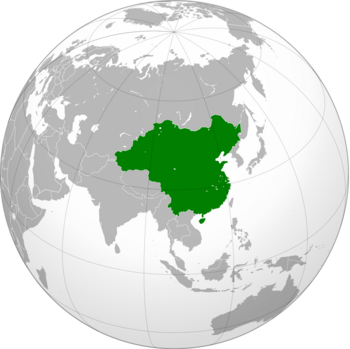User:TheodoresTomfooleries/Sandbox: Difference between revisions
Jump to navigation
Jump to search
m (Just adding some information at the top :)) |
(Added national anthem, motto, flag & coat of arms as well as a map. Fixed up population & area and added HDI.) |
||
| Line 5: | Line 5: | ||
|native_name = ''大中华区'' (Chinese)<br><small>''Da Junghua chiu'' (Ruoha)</small> | |native_name = ''大中华区'' (Chinese)<br><small>''Da Junghua chiu'' (Ruoha)</small> | ||
|common_name = China | |common_name = China | ||
|image_flag = | |image_flag = NatZhonghua.png | ||
|image_coat = | |image_coat = Twelve_Symbols_national_emblem_of_China.svg | ||
|national_motto = | |national_motto = 三民主義 (Chinese)<br>"Three Principles of the People" | ||
|national_anthem = | |national_anthem = [[File:MediaPlayer.png|link=https://www.youtube.com/watch?v=XWv4b6cAV-E]] | ||
|image_map = | |image_map = Empire of China.png | ||
|map_caption = Map of China during the Empire, | |map_caption = Map of China during the Empire, right after the Second World War. | ||
|capital = Beijing | |capital = Beijing | ||
|largest_city = | |largest_city = Shanghai | ||
|official_languages = Standard Chinese | |official_languages = Standard Chinese | ||
|regional_languages = Mongolian | |regional_languages = Mongolian | ||
| Line 23: | Line 23: | ||
|legislature = National Assembly | |legislature = National Assembly | ||
|sovereignty_type = Formation and History | |sovereignty_type = Formation and History | ||
|established_event1 = | |established_event1 = {{wp|https://en.wikipedia.org/wiki/1911_Revolution|Xinhai Revolution}} | ||
|established_date1 = 10 October, 1911 | |established_date1 = 10 October, 1911 | ||
|established_event2= Declaration of the | |established_event2= Declaration of the {{wp|https://en.wikipedia.org/wiki/Provisional_Government_of_the_Republic_of_China_(1912)|Republic of China}} | ||
|established_date2= 1 January, 1912 | |established_date2= 1 January, 1912 | ||
|established_event3= Dissolution of the | |established_event3= Dissolution of the {{wp|https://en.wikipedia.org/wiki/Qing_dynasty|Qing dynasty}} | ||
|established_date3= 12 February, 1912 | |established_date3= 12 February, 1912 | ||
|established_event4= | |established_event4={{wp|https://en.wikipedia.org/wiki/Empire_of_China_(1915%E2%80%931916)|Empire of China (Yuan Shikai)}} and {{wp|https://en.wikipedia.org/wiki/Warlord_Era|Warlord Era}} | ||
|established_date4=1915-1916 | |established_date4=1915-1916 | ||
|established_event5=Great Chinese Civil Wars | |established_event5=Great Chinese Civil Wars | ||
| Line 35: | Line 35: | ||
|established_event6=Declaration of the Great Chinese Realm | |established_event6=Declaration of the Great Chinese Realm | ||
|established_date6=5 August, 1920 | |established_date6=5 August, 1920 | ||
|established_event7=Entrance into | |established_event7=Entrance into {{wp|https://en.wikipedia.org/wiki/World_War_II|World War II}} | ||
|established_date7=8 June, 1944 | |established_date7=8 June, 1944 | ||
|established_event8=Death of Hu Wanjing | |established_event8=Death of Hu Wanjing | ||
| Line 45: | Line 45: | ||
|established_event11=Dissolution | |established_event11=Dissolution | ||
|established_date11=5 August, 1995 | |established_date11=5 August, 1995 | ||
|area_km2= | |area_km2=10103177 | ||
|area_sq_mi= | |area_sq_mi=3900858 | ||
|population_census = 829 million | |population_census = 829.7 million | ||
|population_census_year = 1990 | |population_census_year = 1990 | ||
|population_density_km2 = 82. | |population_density_km2 = 82.12 | ||
|population_density_sq_mi = 212. | |population_density_sq_mi = 212.69 | ||
|GDP_nominal = $4.1 trillion | |GDP_nominal = $4.1 trillion | ||
|GDP_nominal_year = 1990 | |GDP_nominal_year = 1990 | ||
|GDP_nominal_per_capita = $4, | |GDP_nominal_per_capita = $4,941 | ||
|HDI = | |HDI = 0.729 | ||
|HDI_year = 1990 | |HDI_year = 1990 | ||
|currency = Chinese Yuan | |currency = Chinese Yuan | ||
Revision as of 21:22, 3 February 2022
Sandbox and testing place for me, don't mind me!
Great Chinese Realm 大中华区 (Chinese) Da Junghua chiu (Ruoha) | |
|---|---|
| Motto: 三民主義 (Chinese) "Three Principles of the People" | |
| Anthem: | |
 Map of China during the Empire, right after the Second World War. | |
| Capital | Beijing |
| Largest city | Shanghai |
| Official languages | Standard Chinese |
| Recognised regional languages | Mongolian |
| Ethnic groups (1992) | 93.2% Han Chinese 6.8% Others |
| Demonym(s) | Chinese |
| Government | Unitary one-party presidential republic under a nationalistic dictatorship (1920-1992) Unitary one-party presidential republic (1992-1995) |
• President of China | First: Hu Wanjing (1920-1952) Last: Chen Jingyun (1991-1995) |
| Legislature | National Assembly |
| Formation and History | |
| 10 October, 1911 | |
• Declaration of the Republic of China | 1 January, 1912 |
• Dissolution of the Qing dynasty | 12 February, 1912 |
| 1915-1916 | |
• Great Chinese Civil Wars | 1917-1920 |
• Declaration of the Great Chinese Realm | 5 August, 1920 |
• Entrance into World War II | 8 June, 1944 |
• Death of Hu Wanjing | 2 May, 1952 |
• New Golden Age | 1958-1964 |
• Deautocratization | 1991-1994 |
• Dissolution | 5 August, 1995 |
| Area | |
• Total | 10,103,177 km2 (3,900,858 sq mi) |
| Population | |
• 1990 census | 829.7 million |
• Density | 82.12/km2 (212.7/sq mi) |
| GDP (nominal) | 1990 estimate |
• Total | $4.1 trillion |
• Per capita | $4,941 |
| HDI (1990) | 0.729 high |
| Currency | Chinese Yuan |
| Time zone | UTC+5:30 - UTC+8:30 |
| Date format | yy-mm-dd |
| Driving side | right |
| Calling code | +86 |
| ISO 3166 code | CN |
| Internet TLD | .cn |
The Empire of China (Chinese: 中华帝国; Ruohua: Jonghua deguo), officially the Great Chinese Realm (Chinese: 大中华区; Ruoha: Da Junghua chiu), was the period in Chinese history from the Fifth of August 1920 to 1995, during which China and Outer Mongolia were governed as a unitary, authoritarian one-party dictatorship by the Hanzudang.
